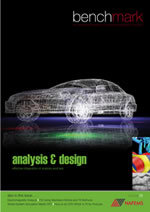benchmark October 2009
Analysis and Design - effective integration of analysis and test

In this issue:
You will need to login above to access these files.
This week, I changed a lightbulb. In fact, in the past few weeks, I’ve changed many lightbulbs. In the spirit of environmental accountability, we’ve switched every lightbulb in our home to an ‘energy-saver’, giving us a wonderful sense of ‘doing something’ to help the environment, as well as that annoying initial 20-30 second period of dim-light around the home. But these are not the lightbulbs I wanted to focus on. I changed the headlamp bulb in my car. A simple task, for the most part, and one which you would think would be possible on the side of the road in the dark in case of emergency (I was in the driveway in the sunshine, but you get the picture). But no. In order to complete this routine maintenance task, the entire headlamp assembly requires to be disconnected from the battery, unscrewed from the car body, unclipped, taken off of the front of the car, more unclipping, more disconnection, before finally you have access to the offending lightbulb.
Where am I going with this? Design. Someone designed that process. Someone thought that the optimum design was one which required the fitting to be stripped from the body of the car to be serviced. Someone made the decision that this was an acceptable process to go through to change a lightbulb. Someone thought this it was a good idea to change from the “open bonnet / unclip bulb-housing / change bulb / close bonnet” routine that I remember from my first car, to this 12-step process requiring a reference manual.
Now, I’m sure there is a reason that this process is so annoying. I’m sure that by designing and mounting the headlamp in this way, some cost/weight/production/design savings were made, or at least the production process was significantly improved. Surely? I would certainly hope so, otherwise the design could be described as “sloppy” at best. But the question is: have we really sacrificed the Focus (hint...) on the end-user so much that we are prepared to design things in such a way as to make their job or experience knowledgably worse in order to save a few bucks? Do we still design with the ultimate satisfaction of the consumer/customer/owner/passenger in mind, or has this slipped down the order of importance behind efficiency and cost?
The dangers of over-optimisation are now receiving wider coverage in the analysis community, and we should learn from other sectors and industries which have been there before. Whilst efficient design, cost savings and production efficiency are vital, especially in today’s marketplace, we should never lose sight of the fact that every product is designed to be used. That is the main purpose. If design optimisation makes for a more difficult, less satisfactory user experience, is it the correct thing to do? If the addition of analysis and simulation to a design process leads to anything other than an enhanced user experience, in terms of either safety, efficiency, ease of use of cost-savings, then do we have to re-examine its value?
You’ll be happy to know that I did manage to change the lightbulb in the end.
David Quinn I Editor I david.quinn@nafems.org I twitter.com/benchtweet




